University Public Health Report: Depression in Elderly, India
VerifiedAdded on 2023/04/04
|14
|2779
|115
Report
AI Summary
This report delves into the critical public health issue of depression among the elderly population in India. It begins by establishing the global and national context of depression, highlighting its prevalence, projected increase, and burden of disease, particularly in low- and middle-income countries like India. The report then focuses on the Indian context, citing studies on the prevalence of depression among the elderly and the associated risk factors. It identifies socioeconomic factors, such as income and education levels, and psychological factors, including adverse life events and social isolation, as key contributors to depression. The report underscores the need for interventions and emphasizes the significance of addressing these factors to improve the mental health and quality of life for the elderly population in India. The analysis emphasizes the importance of recognizing depression as a leading public health concern, and the need for further research and interventions to mitigate the impact of depression on the aging population.
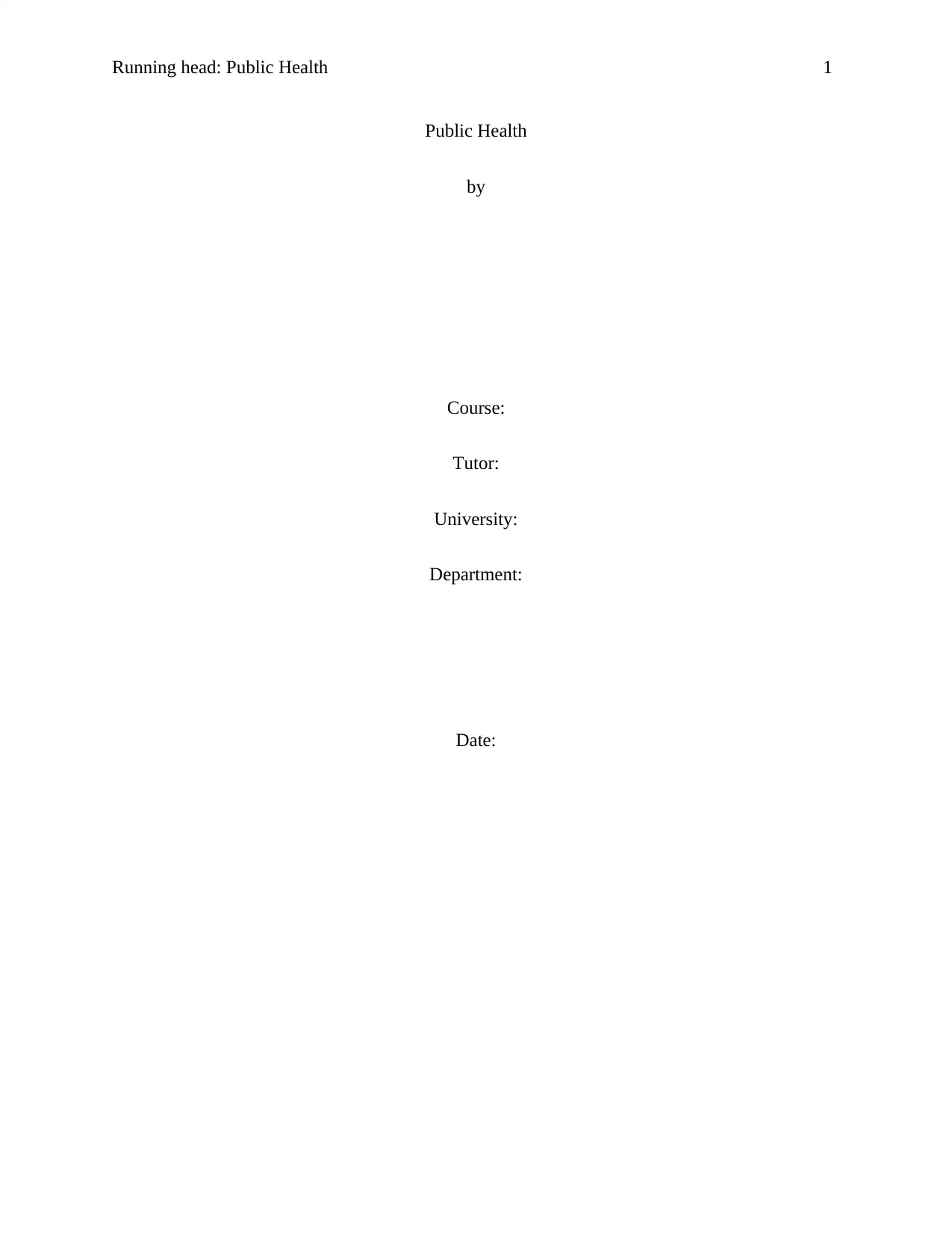
Running head: Public Health 1
Public Health
by
Course:
Tutor:
University:
Department:
Date:
Public Health
by
Course:
Tutor:
University:
Department:
Date:
Paraphrase This Document
Need a fresh take? Get an instant paraphrase of this document with our AI Paraphraser
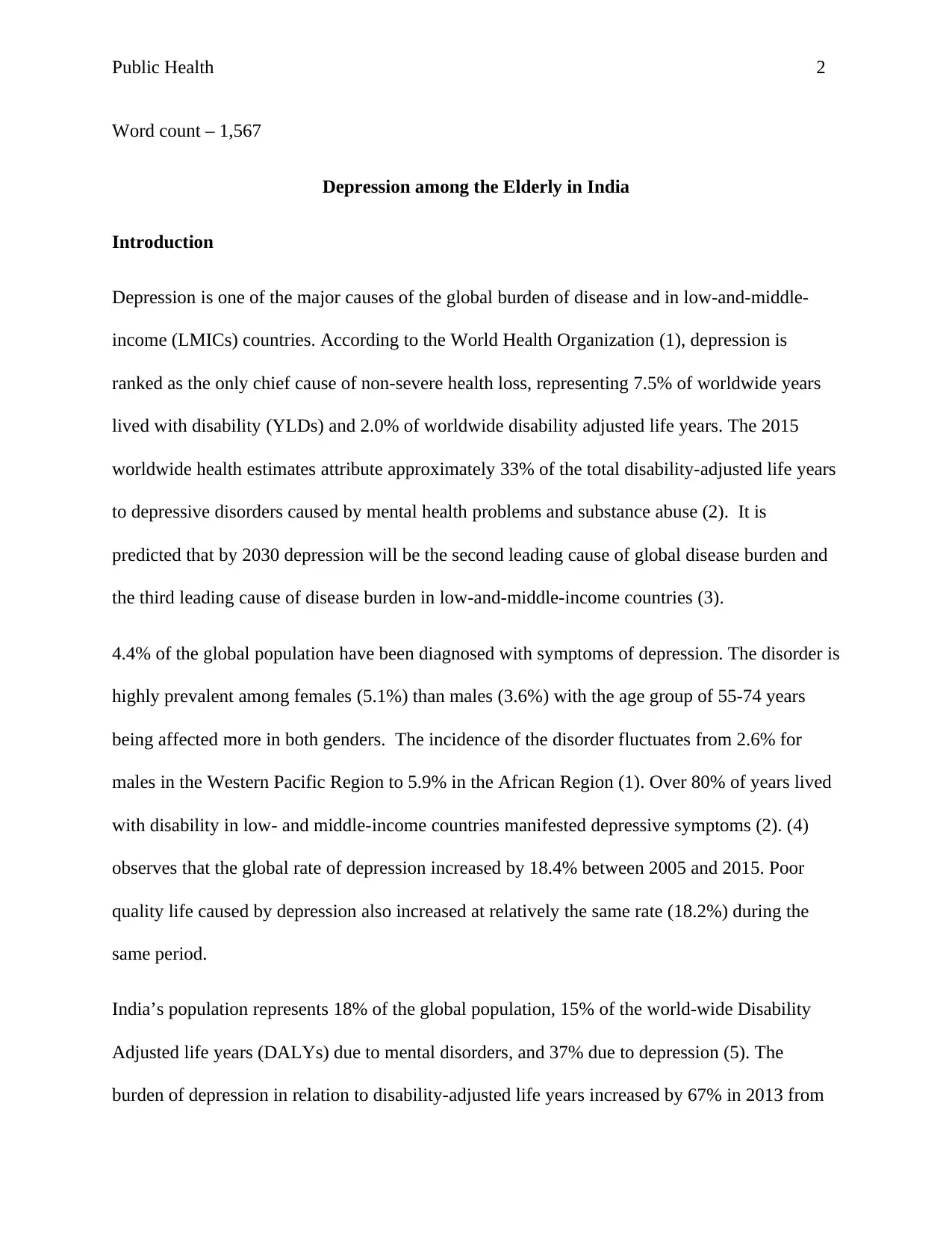
Public Health 2
Word count – 1,567
Depression among the Elderly in India
Introduction
Depression is one of the major causes of the global burden of disease and in low-and-middle-
income (LMICs) countries. According to the World Health Organization (1), depression is
ranked as the only chief cause of non-severe health loss, representing 7.5% of worldwide years
lived with disability (YLDs) and 2.0% of worldwide disability adjusted life years. The 2015
worldwide health estimates attribute approximately 33% of the total disability-adjusted life years
to depressive disorders caused by mental health problems and substance abuse (2). It is
predicted that by 2030 depression will be the second leading cause of global disease burden and
the third leading cause of disease burden in low-and-middle-income countries (3).
4.4% of the global population have been diagnosed with symptoms of depression. The disorder is
highly prevalent among females (5.1%) than males (3.6%) with the age group of 55-74 years
being affected more in both genders. The incidence of the disorder fluctuates from 2.6% for
males in the Western Pacific Region to 5.9% in the African Region (1). Over 80% of years lived
with disability in low- and middle-income countries manifested depressive symptoms (2). (4)
observes that the global rate of depression increased by 18.4% between 2005 and 2015. Poor
quality life caused by depression also increased at relatively the same rate (18.2%) during the
same period.
India’s population represents 18% of the global population, 15% of the world-wide Disability
Adjusted life years (DALYs) due to mental disorders, and 37% due to depression (5). The
burden of depression in relation to disability-adjusted life years increased by 67% in 2013 from
Word count – 1,567
Depression among the Elderly in India
Introduction
Depression is one of the major causes of the global burden of disease and in low-and-middle-
income (LMICs) countries. According to the World Health Organization (1), depression is
ranked as the only chief cause of non-severe health loss, representing 7.5% of worldwide years
lived with disability (YLDs) and 2.0% of worldwide disability adjusted life years. The 2015
worldwide health estimates attribute approximately 33% of the total disability-adjusted life years
to depressive disorders caused by mental health problems and substance abuse (2). It is
predicted that by 2030 depression will be the second leading cause of global disease burden and
the third leading cause of disease burden in low-and-middle-income countries (3).
4.4% of the global population have been diagnosed with symptoms of depression. The disorder is
highly prevalent among females (5.1%) than males (3.6%) with the age group of 55-74 years
being affected more in both genders. The incidence of the disorder fluctuates from 2.6% for
males in the Western Pacific Region to 5.9% in the African Region (1). Over 80% of years lived
with disability in low- and middle-income countries manifested depressive symptoms (2). (4)
observes that the global rate of depression increased by 18.4% between 2005 and 2015. Poor
quality life caused by depression also increased at relatively the same rate (18.2%) during the
same period.
India’s population represents 18% of the global population, 15% of the world-wide Disability
Adjusted life years (DALYs) due to mental disorders, and 37% due to depression (5). The
burden of depression in relation to disability-adjusted life years increased by 67% in 2013 from
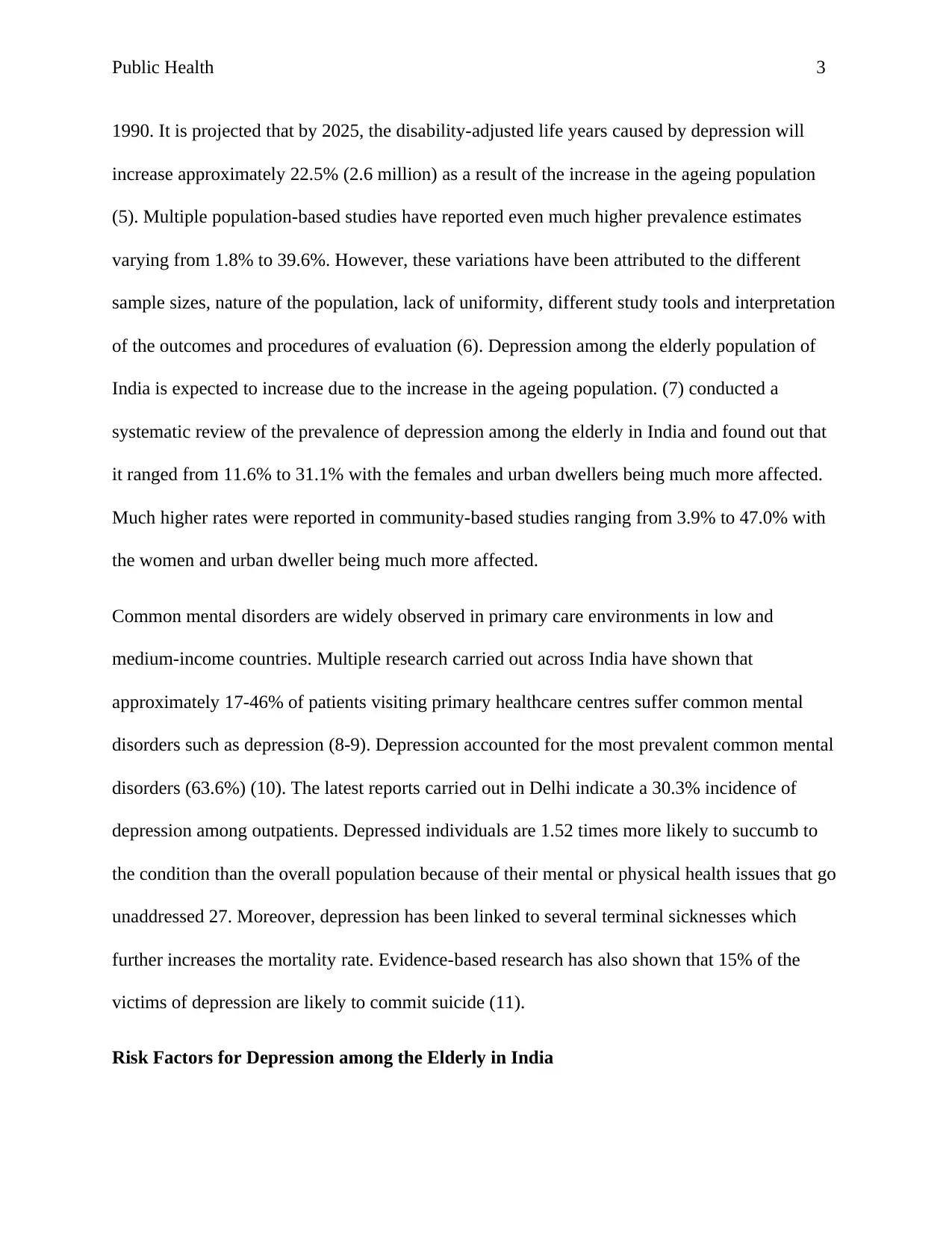
Public Health 3
1990. It is projected that by 2025, the disability-adjusted life years caused by depression will
increase approximately 22.5% (2.6 million) as a result of the increase in the ageing population
(5). Multiple population-based studies have reported even much higher prevalence estimates
varying from 1.8% to 39.6%. However, these variations have been attributed to the different
sample sizes, nature of the population, lack of uniformity, different study tools and interpretation
of the outcomes and procedures of evaluation (6). Depression among the elderly population of
India is expected to increase due to the increase in the ageing population. (7) conducted a
systematic review of the prevalence of depression among the elderly in India and found out that
it ranged from 11.6% to 31.1% with the females and urban dwellers being much more affected.
Much higher rates were reported in community-based studies ranging from 3.9% to 47.0% with
the women and urban dweller being much more affected.
Common mental disorders are widely observed in primary care environments in low and
medium-income countries. Multiple research carried out across India have shown that
approximately 17-46% of patients visiting primary healthcare centres suffer common mental
disorders such as depression (8-9). Depression accounted for the most prevalent common mental
disorders (63.6%) (10). The latest reports carried out in Delhi indicate a 30.3% incidence of
depression among outpatients. Depressed individuals are 1.52 times more likely to succumb to
the condition than the overall population because of their mental or physical health issues that go
unaddressed 27. Moreover, depression has been linked to several terminal sicknesses which
further increases the mortality rate. Evidence-based research has also shown that 15% of the
victims of depression are likely to commit suicide (11).
Risk Factors for Depression among the Elderly in India
1990. It is projected that by 2025, the disability-adjusted life years caused by depression will
increase approximately 22.5% (2.6 million) as a result of the increase in the ageing population
(5). Multiple population-based studies have reported even much higher prevalence estimates
varying from 1.8% to 39.6%. However, these variations have been attributed to the different
sample sizes, nature of the population, lack of uniformity, different study tools and interpretation
of the outcomes and procedures of evaluation (6). Depression among the elderly population of
India is expected to increase due to the increase in the ageing population. (7) conducted a
systematic review of the prevalence of depression among the elderly in India and found out that
it ranged from 11.6% to 31.1% with the females and urban dwellers being much more affected.
Much higher rates were reported in community-based studies ranging from 3.9% to 47.0% with
the women and urban dweller being much more affected.
Common mental disorders are widely observed in primary care environments in low and
medium-income countries. Multiple research carried out across India have shown that
approximately 17-46% of patients visiting primary healthcare centres suffer common mental
disorders such as depression (8-9). Depression accounted for the most prevalent common mental
disorders (63.6%) (10). The latest reports carried out in Delhi indicate a 30.3% incidence of
depression among outpatients. Depressed individuals are 1.52 times more likely to succumb to
the condition than the overall population because of their mental or physical health issues that go
unaddressed 27. Moreover, depression has been linked to several terminal sicknesses which
further increases the mortality rate. Evidence-based research has also shown that 15% of the
victims of depression are likely to commit suicide (11).
Risk Factors for Depression among the Elderly in India
⊘ This is a preview!⊘
Do you want full access?
Subscribe today to unlock all pages.

Trusted by 1+ million students worldwide
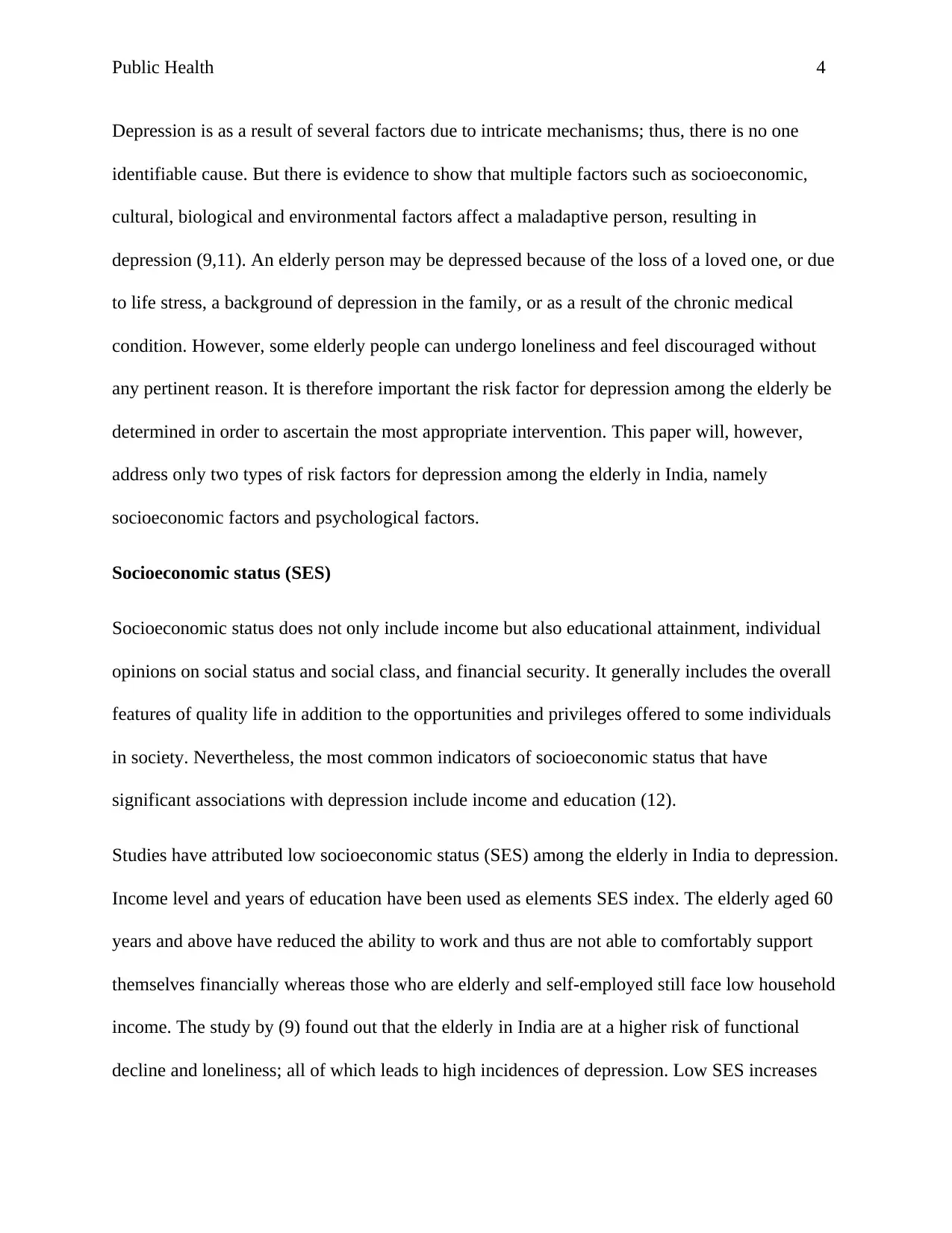
Public Health 4
Depression is as a result of several factors due to intricate mechanisms; thus, there is no one
identifiable cause. But there is evidence to show that multiple factors such as socioeconomic,
cultural, biological and environmental factors affect a maladaptive person, resulting in
depression (9,11). An elderly person may be depressed because of the loss of a loved one, or due
to life stress, a background of depression in the family, or as a result of the chronic medical
condition. However, some elderly people can undergo loneliness and feel discouraged without
any pertinent reason. It is therefore important the risk factor for depression among the elderly be
determined in order to ascertain the most appropriate intervention. This paper will, however,
address only two types of risk factors for depression among the elderly in India, namely
socioeconomic factors and psychological factors.
Socioeconomic status (SES)
Socioeconomic status does not only include income but also educational attainment, individual
opinions on social status and social class, and financial security. It generally includes the overall
features of quality life in addition to the opportunities and privileges offered to some individuals
in society. Nevertheless, the most common indicators of socioeconomic status that have
significant associations with depression include income and education (12).
Studies have attributed low socioeconomic status (SES) among the elderly in India to depression.
Income level and years of education have been used as elements SES index. The elderly aged 60
years and above have reduced the ability to work and thus are not able to comfortably support
themselves financially whereas those who are elderly and self-employed still face low household
income. The study by (9) found out that the elderly in India are at a higher risk of functional
decline and loneliness; all of which leads to high incidences of depression. Low SES increases
Depression is as a result of several factors due to intricate mechanisms; thus, there is no one
identifiable cause. But there is evidence to show that multiple factors such as socioeconomic,
cultural, biological and environmental factors affect a maladaptive person, resulting in
depression (9,11). An elderly person may be depressed because of the loss of a loved one, or due
to life stress, a background of depression in the family, or as a result of the chronic medical
condition. However, some elderly people can undergo loneliness and feel discouraged without
any pertinent reason. It is therefore important the risk factor for depression among the elderly be
determined in order to ascertain the most appropriate intervention. This paper will, however,
address only two types of risk factors for depression among the elderly in India, namely
socioeconomic factors and psychological factors.
Socioeconomic status (SES)
Socioeconomic status does not only include income but also educational attainment, individual
opinions on social status and social class, and financial security. It generally includes the overall
features of quality life in addition to the opportunities and privileges offered to some individuals
in society. Nevertheless, the most common indicators of socioeconomic status that have
significant associations with depression include income and education (12).
Studies have attributed low socioeconomic status (SES) among the elderly in India to depression.
Income level and years of education have been used as elements SES index. The elderly aged 60
years and above have reduced the ability to work and thus are not able to comfortably support
themselves financially whereas those who are elderly and self-employed still face low household
income. The study by (9) found out that the elderly in India are at a higher risk of functional
decline and loneliness; all of which leads to high incidences of depression. Low SES increases
Paraphrase This Document
Need a fresh take? Get an instant paraphrase of this document with our AI Paraphraser
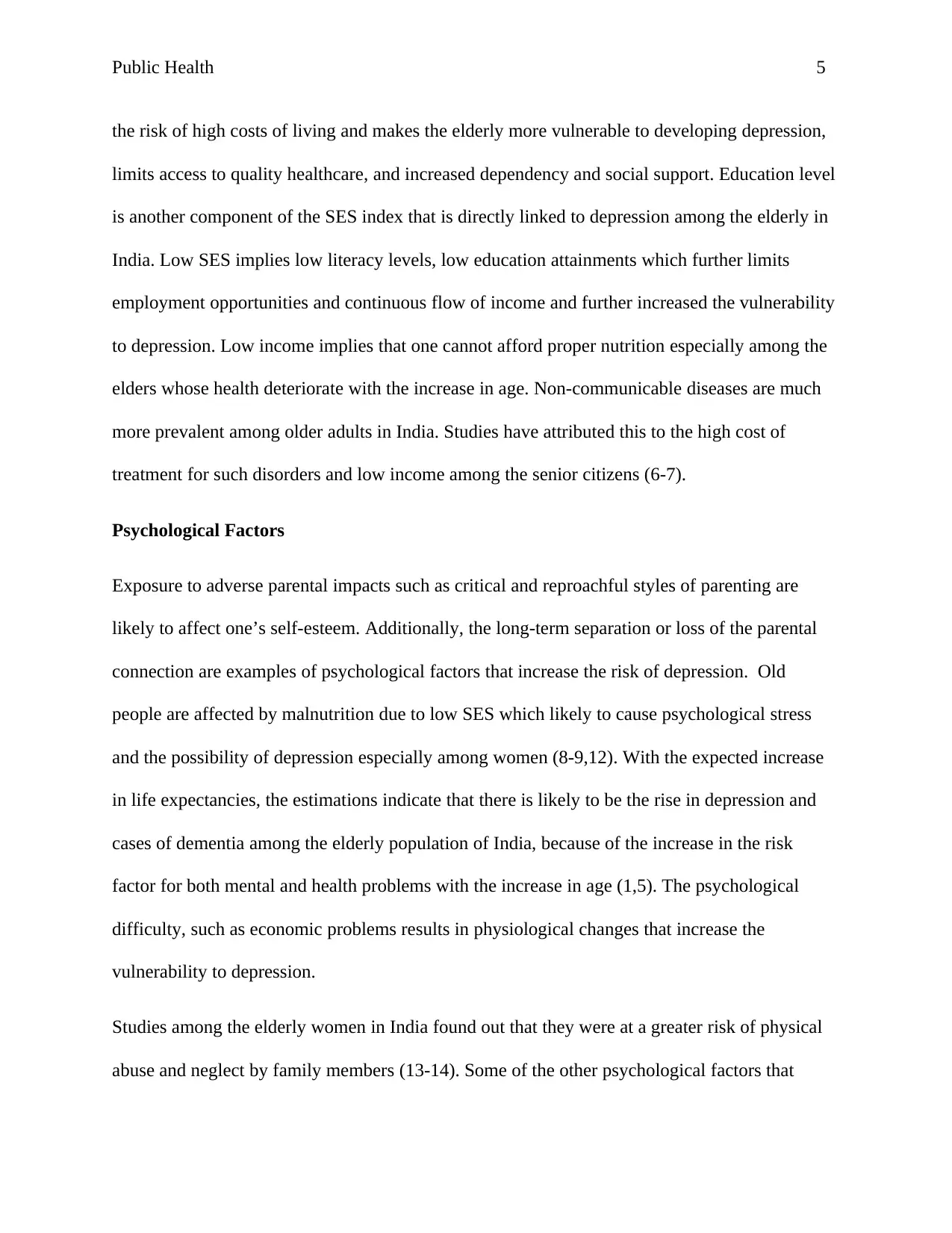
Public Health 5
the risk of high costs of living and makes the elderly more vulnerable to developing depression,
limits access to quality healthcare, and increased dependency and social support. Education level
is another component of the SES index that is directly linked to depression among the elderly in
India. Low SES implies low literacy levels, low education attainments which further limits
employment opportunities and continuous flow of income and further increased the vulnerability
to depression. Low income implies that one cannot afford proper nutrition especially among the
elders whose health deteriorate with the increase in age. Non-communicable diseases are much
more prevalent among older adults in India. Studies have attributed this to the high cost of
treatment for such disorders and low income among the senior citizens (6-7).
Psychological Factors
Exposure to adverse parental impacts such as critical and reproachful styles of parenting are
likely to affect one’s self-esteem. Additionally, the long-term separation or loss of the parental
connection are examples of psychological factors that increase the risk of depression. Old
people are affected by malnutrition due to low SES which likely to cause psychological stress
and the possibility of depression especially among women (8-9,12). With the expected increase
in life expectancies, the estimations indicate that there is likely to be the rise in depression and
cases of dementia among the elderly population of India, because of the increase in the risk
factor for both mental and health problems with the increase in age (1,5). The psychological
difficulty, such as economic problems results in physiological changes that increase the
vulnerability to depression.
Studies among the elderly women in India found out that they were at a greater risk of physical
abuse and neglect by family members (13-14). Some of the other psychological factors that
the risk of high costs of living and makes the elderly more vulnerable to developing depression,
limits access to quality healthcare, and increased dependency and social support. Education level
is another component of the SES index that is directly linked to depression among the elderly in
India. Low SES implies low literacy levels, low education attainments which further limits
employment opportunities and continuous flow of income and further increased the vulnerability
to depression. Low income implies that one cannot afford proper nutrition especially among the
elders whose health deteriorate with the increase in age. Non-communicable diseases are much
more prevalent among older adults in India. Studies have attributed this to the high cost of
treatment for such disorders and low income among the senior citizens (6-7).
Psychological Factors
Exposure to adverse parental impacts such as critical and reproachful styles of parenting are
likely to affect one’s self-esteem. Additionally, the long-term separation or loss of the parental
connection are examples of psychological factors that increase the risk of depression. Old
people are affected by malnutrition due to low SES which likely to cause psychological stress
and the possibility of depression especially among women (8-9,12). With the expected increase
in life expectancies, the estimations indicate that there is likely to be the rise in depression and
cases of dementia among the elderly population of India, because of the increase in the risk
factor for both mental and health problems with the increase in age (1,5). The psychological
difficulty, such as economic problems results in physiological changes that increase the
vulnerability to depression.
Studies among the elderly women in India found out that they were at a greater risk of physical
abuse and neglect by family members (13-14). Some of the other psychological factors that
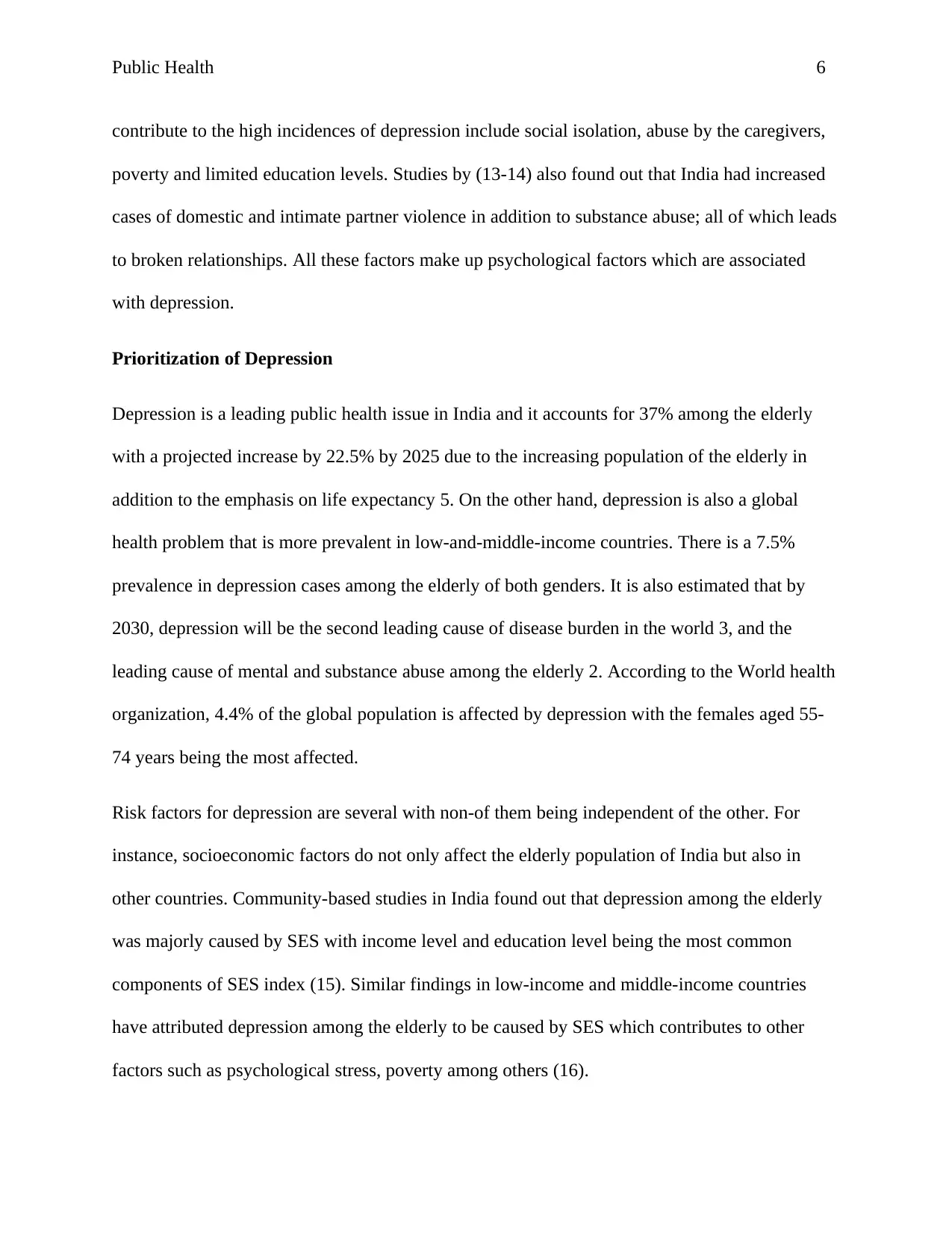
Public Health 6
contribute to the high incidences of depression include social isolation, abuse by the caregivers,
poverty and limited education levels. Studies by (13-14) also found out that India had increased
cases of domestic and intimate partner violence in addition to substance abuse; all of which leads
to broken relationships. All these factors make up psychological factors which are associated
with depression.
Prioritization of Depression
Depression is a leading public health issue in India and it accounts for 37% among the elderly
with a projected increase by 22.5% by 2025 due to the increasing population of the elderly in
addition to the emphasis on life expectancy 5. On the other hand, depression is also a global
health problem that is more prevalent in low-and-middle-income countries. There is a 7.5%
prevalence in depression cases among the elderly of both genders. It is also estimated that by
2030, depression will be the second leading cause of disease burden in the world 3, and the
leading cause of mental and substance abuse among the elderly 2. According to the World health
organization, 4.4% of the global population is affected by depression with the females aged 55-
74 years being the most affected.
Risk factors for depression are several with non-of them being independent of the other. For
instance, socioeconomic factors do not only affect the elderly population of India but also in
other countries. Community-based studies in India found out that depression among the elderly
was majorly caused by SES with income level and education level being the most common
components of SES index (15). Similar findings in low-income and middle-income countries
have attributed depression among the elderly to be caused by SES which contributes to other
factors such as psychological stress, poverty among others (16).
contribute to the high incidences of depression include social isolation, abuse by the caregivers,
poverty and limited education levels. Studies by (13-14) also found out that India had increased
cases of domestic and intimate partner violence in addition to substance abuse; all of which leads
to broken relationships. All these factors make up psychological factors which are associated
with depression.
Prioritization of Depression
Depression is a leading public health issue in India and it accounts for 37% among the elderly
with a projected increase by 22.5% by 2025 due to the increasing population of the elderly in
addition to the emphasis on life expectancy 5. On the other hand, depression is also a global
health problem that is more prevalent in low-and-middle-income countries. There is a 7.5%
prevalence in depression cases among the elderly of both genders. It is also estimated that by
2030, depression will be the second leading cause of disease burden in the world 3, and the
leading cause of mental and substance abuse among the elderly 2. According to the World health
organization, 4.4% of the global population is affected by depression with the females aged 55-
74 years being the most affected.
Risk factors for depression are several with non-of them being independent of the other. For
instance, socioeconomic factors do not only affect the elderly population of India but also in
other countries. Community-based studies in India found out that depression among the elderly
was majorly caused by SES with income level and education level being the most common
components of SES index (15). Similar findings in low-income and middle-income countries
have attributed depression among the elderly to be caused by SES which contributes to other
factors such as psychological stress, poverty among others (16).
⊘ This is a preview!⊘
Do you want full access?
Subscribe today to unlock all pages.

Trusted by 1+ million students worldwide
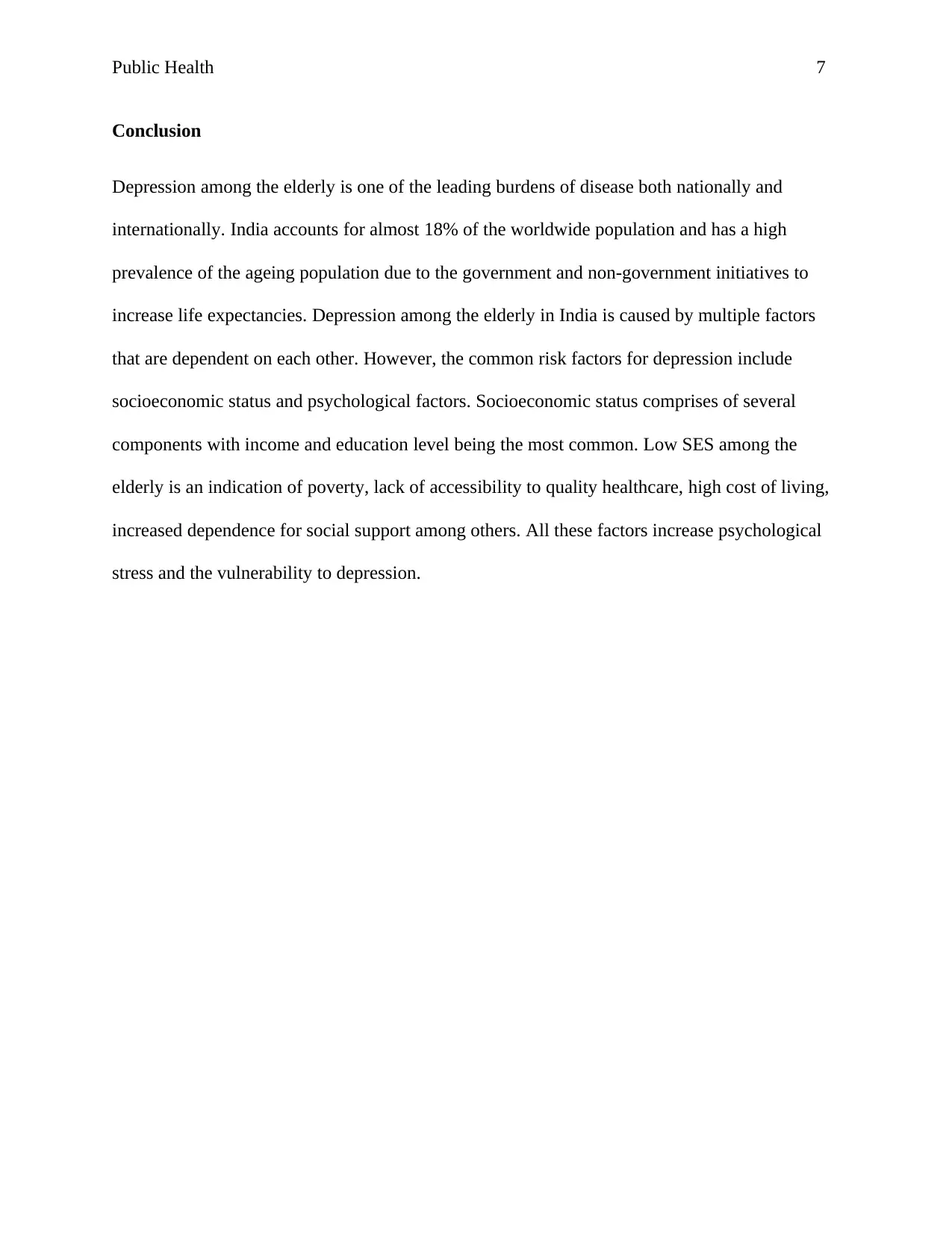
Public Health 7
Conclusion
Depression among the elderly is one of the leading burdens of disease both nationally and
internationally. India accounts for almost 18% of the worldwide population and has a high
prevalence of the ageing population due to the government and non-government initiatives to
increase life expectancies. Depression among the elderly in India is caused by multiple factors
that are dependent on each other. However, the common risk factors for depression include
socioeconomic status and psychological factors. Socioeconomic status comprises of several
components with income and education level being the most common. Low SES among the
elderly is an indication of poverty, lack of accessibility to quality healthcare, high cost of living,
increased dependence for social support among others. All these factors increase psychological
stress and the vulnerability to depression.
Conclusion
Depression among the elderly is one of the leading burdens of disease both nationally and
internationally. India accounts for almost 18% of the worldwide population and has a high
prevalence of the ageing population due to the government and non-government initiatives to
increase life expectancies. Depression among the elderly in India is caused by multiple factors
that are dependent on each other. However, the common risk factors for depression include
socioeconomic status and psychological factors. Socioeconomic status comprises of several
components with income and education level being the most common. Low SES among the
elderly is an indication of poverty, lack of accessibility to quality healthcare, high cost of living,
increased dependence for social support among others. All these factors increase psychological
stress and the vulnerability to depression.
Paraphrase This Document
Need a fresh take? Get an instant paraphrase of this document with our AI Paraphraser
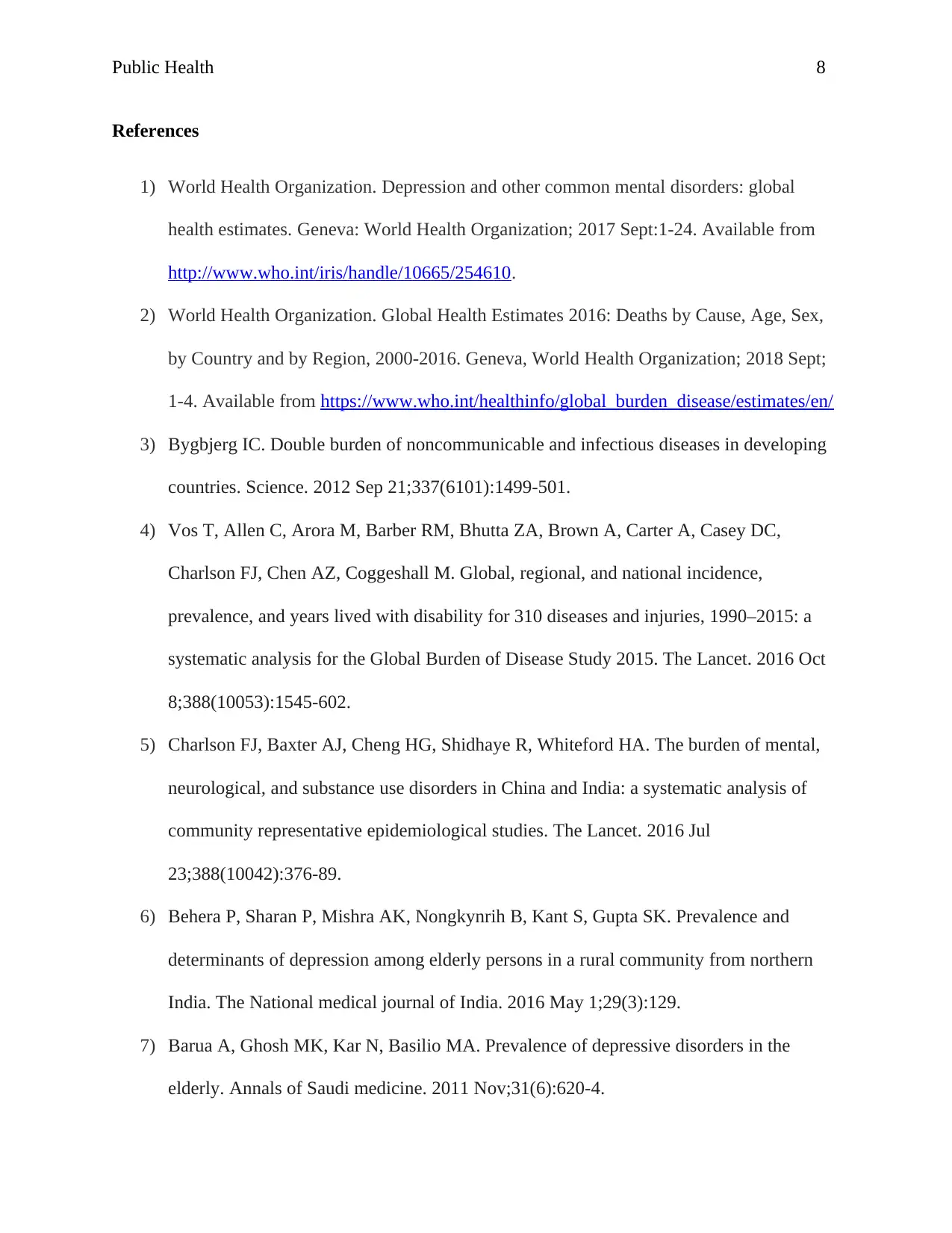
Public Health 8
References
1) World Health Organization. Depression and other common mental disorders: global
health estimates. Geneva: World Health Organization; 2017 Sept:1-24. Available from
http://www.who.int/iris/handle/10665/254610.
2) World Health Organization. Global Health Estimates 2016: Deaths by Cause, Age, Sex,
by Country and by Region, 2000-2016. Geneva, World Health Organization; 2018 Sept;
1-4. Available from https://www.who.int/healthinfo/global_burden_disease/estimates/en/
3) Bygbjerg IC. Double burden of noncommunicable and infectious diseases in developing
countries. Science. 2012 Sep 21;337(6101):1499-501.
4) Vos T, Allen C, Arora M, Barber RM, Bhutta ZA, Brown A, Carter A, Casey DC,
Charlson FJ, Chen AZ, Coggeshall M. Global, regional, and national incidence,
prevalence, and years lived with disability for 310 diseases and injuries, 1990–2015: a
systematic analysis for the Global Burden of Disease Study 2015. The Lancet. 2016 Oct
8;388(10053):1545-602.
5) Charlson FJ, Baxter AJ, Cheng HG, Shidhaye R, Whiteford HA. The burden of mental,
neurological, and substance use disorders in China and India: a systematic analysis of
community representative epidemiological studies. The Lancet. 2016 Jul
23;388(10042):376-89.
6) Behera P, Sharan P, Mishra AK, Nongkynrih B, Kant S, Gupta SK. Prevalence and
determinants of depression among elderly persons in a rural community from northern
India. The National medical journal of India. 2016 May 1;29(3):129.
7) Barua A, Ghosh MK, Kar N, Basilio MA. Prevalence of depressive disorders in the
elderly. Annals of Saudi medicine. 2011 Nov;31(6):620-4.
References
1) World Health Organization. Depression and other common mental disorders: global
health estimates. Geneva: World Health Organization; 2017 Sept:1-24. Available from
http://www.who.int/iris/handle/10665/254610.
2) World Health Organization. Global Health Estimates 2016: Deaths by Cause, Age, Sex,
by Country and by Region, 2000-2016. Geneva, World Health Organization; 2018 Sept;
1-4. Available from https://www.who.int/healthinfo/global_burden_disease/estimates/en/
3) Bygbjerg IC. Double burden of noncommunicable and infectious diseases in developing
countries. Science. 2012 Sep 21;337(6101):1499-501.
4) Vos T, Allen C, Arora M, Barber RM, Bhutta ZA, Brown A, Carter A, Casey DC,
Charlson FJ, Chen AZ, Coggeshall M. Global, regional, and national incidence,
prevalence, and years lived with disability for 310 diseases and injuries, 1990–2015: a
systematic analysis for the Global Burden of Disease Study 2015. The Lancet. 2016 Oct
8;388(10053):1545-602.
5) Charlson FJ, Baxter AJ, Cheng HG, Shidhaye R, Whiteford HA. The burden of mental,
neurological, and substance use disorders in China and India: a systematic analysis of
community representative epidemiological studies. The Lancet. 2016 Jul
23;388(10042):376-89.
6) Behera P, Sharan P, Mishra AK, Nongkynrih B, Kant S, Gupta SK. Prevalence and
determinants of depression among elderly persons in a rural community from northern
India. The National medical journal of India. 2016 May 1;29(3):129.
7) Barua A, Ghosh MK, Kar N, Basilio MA. Prevalence of depressive disorders in the
elderly. Annals of Saudi medicine. 2011 Nov;31(6):620-4.
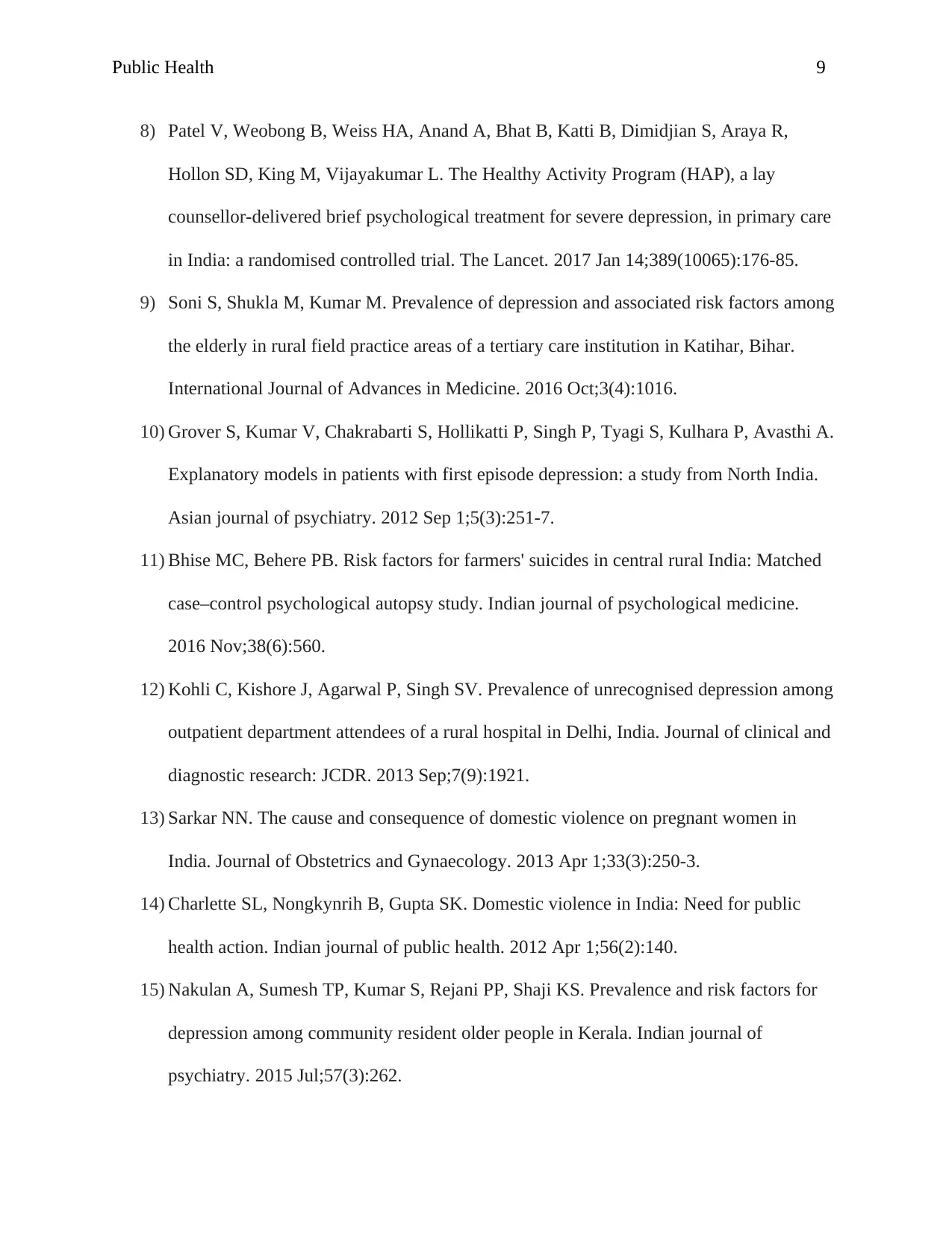
Public Health 9
8) Patel V, Weobong B, Weiss HA, Anand A, Bhat B, Katti B, Dimidjian S, Araya R,
Hollon SD, King M, Vijayakumar L. The Healthy Activity Program (HAP), a lay
counsellor-delivered brief psychological treatment for severe depression, in primary care
in India: a randomised controlled trial. The Lancet. 2017 Jan 14;389(10065):176-85.
9) Soni S, Shukla M, Kumar M. Prevalence of depression and associated risk factors among
the elderly in rural field practice areas of a tertiary care institution in Katihar, Bihar.
International Journal of Advances in Medicine. 2016 Oct;3(4):1016.
10) Grover S, Kumar V, Chakrabarti S, Hollikatti P, Singh P, Tyagi S, Kulhara P, Avasthi A.
Explanatory models in patients with first episode depression: a study from North India.
Asian journal of psychiatry. 2012 Sep 1;5(3):251-7.
11) Bhise MC, Behere PB. Risk factors for farmers' suicides in central rural India: Matched
case–control psychological autopsy study. Indian journal of psychological medicine.
2016 Nov;38(6):560.
12) Kohli C, Kishore J, Agarwal P, Singh SV. Prevalence of unrecognised depression among
outpatient department attendees of a rural hospital in Delhi, India. Journal of clinical and
diagnostic research: JCDR. 2013 Sep;7(9):1921.
13) Sarkar NN. The cause and consequence of domestic violence on pregnant women in
India. Journal of Obstetrics and Gynaecology. 2013 Apr 1;33(3):250-3.
14) Charlette SL, Nongkynrih B, Gupta SK. Domestic violence in India: Need for public
health action. Indian journal of public health. 2012 Apr 1;56(2):140.
15) Nakulan A, Sumesh TP, Kumar S, Rejani PP, Shaji KS. Prevalence and risk factors for
depression among community resident older people in Kerala. Indian journal of
psychiatry. 2015 Jul;57(3):262.
8) Patel V, Weobong B, Weiss HA, Anand A, Bhat B, Katti B, Dimidjian S, Araya R,
Hollon SD, King M, Vijayakumar L. The Healthy Activity Program (HAP), a lay
counsellor-delivered brief psychological treatment for severe depression, in primary care
in India: a randomised controlled trial. The Lancet. 2017 Jan 14;389(10065):176-85.
9) Soni S, Shukla M, Kumar M. Prevalence of depression and associated risk factors among
the elderly in rural field practice areas of a tertiary care institution in Katihar, Bihar.
International Journal of Advances in Medicine. 2016 Oct;3(4):1016.
10) Grover S, Kumar V, Chakrabarti S, Hollikatti P, Singh P, Tyagi S, Kulhara P, Avasthi A.
Explanatory models in patients with first episode depression: a study from North India.
Asian journal of psychiatry. 2012 Sep 1;5(3):251-7.
11) Bhise MC, Behere PB. Risk factors for farmers' suicides in central rural India: Matched
case–control psychological autopsy study. Indian journal of psychological medicine.
2016 Nov;38(6):560.
12) Kohli C, Kishore J, Agarwal P, Singh SV. Prevalence of unrecognised depression among
outpatient department attendees of a rural hospital in Delhi, India. Journal of clinical and
diagnostic research: JCDR. 2013 Sep;7(9):1921.
13) Sarkar NN. The cause and consequence of domestic violence on pregnant women in
India. Journal of Obstetrics and Gynaecology. 2013 Apr 1;33(3):250-3.
14) Charlette SL, Nongkynrih B, Gupta SK. Domestic violence in India: Need for public
health action. Indian journal of public health. 2012 Apr 1;56(2):140.
15) Nakulan A, Sumesh TP, Kumar S, Rejani PP, Shaji KS. Prevalence and risk factors for
depression among community resident older people in Kerala. Indian journal of
psychiatry. 2015 Jul;57(3):262.
⊘ This is a preview!⊘
Do you want full access?
Subscribe today to unlock all pages.

Trusted by 1+ million students worldwide

Public Health 10
16) World Health Organization. Depression in India: Let’s Talk. 2017 Sep; 1-50. Available
from http://www.searo.who.int/india/depression_in_india.pdf
16) World Health Organization. Depression in India: Let’s Talk. 2017 Sep; 1-50. Available
from http://www.searo.who.int/india/depression_in_india.pdf
Paraphrase This Document
Need a fresh take? Get an instant paraphrase of this document with our AI Paraphraser
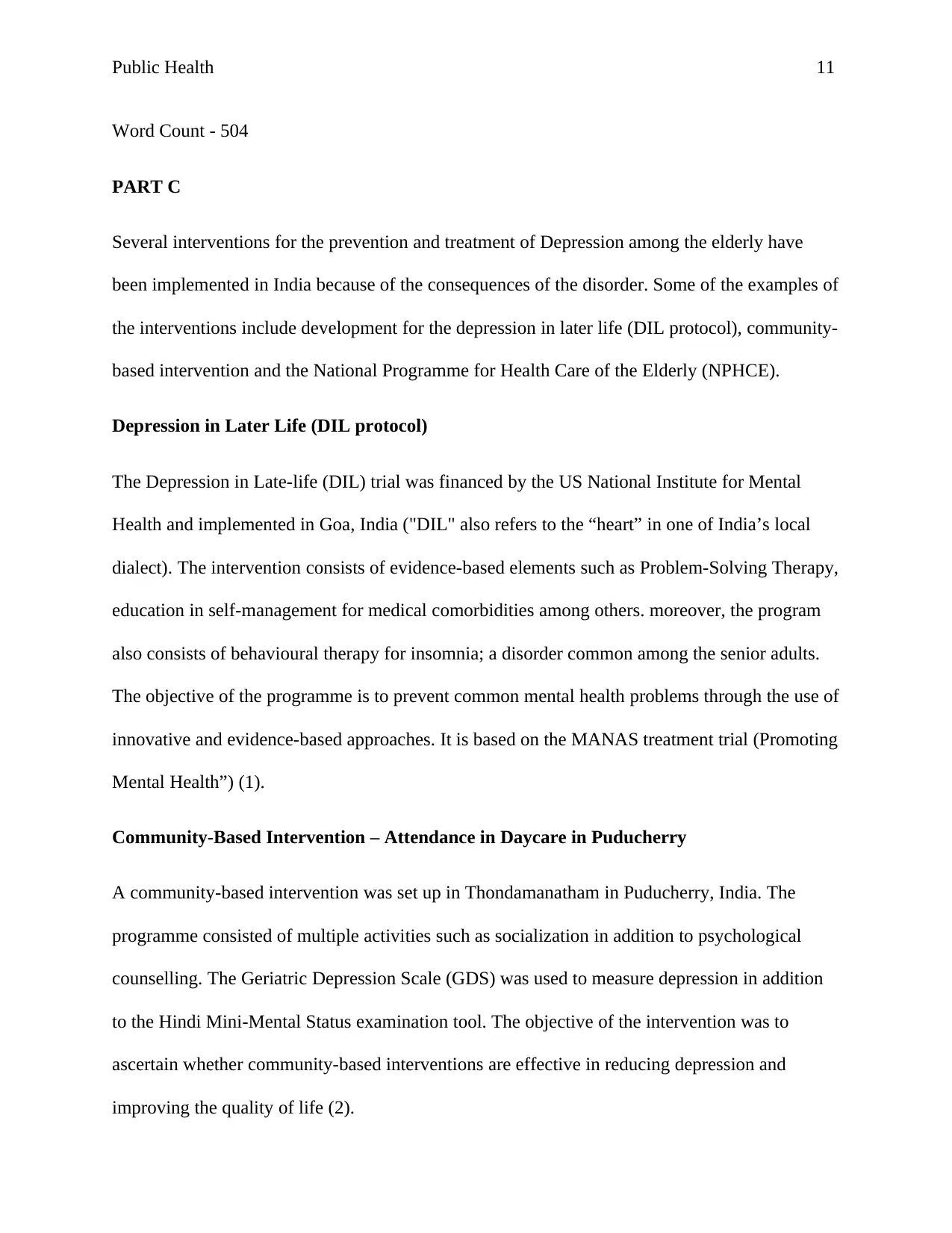
Public Health 11
Word Count - 504
PART C
Several interventions for the prevention and treatment of Depression among the elderly have
been implemented in India because of the consequences of the disorder. Some of the examples of
the interventions include development for the depression in later life (DIL protocol), community-
based intervention and the National Programme for Health Care of the Elderly (NPHCE).
Depression in Later Life (DIL protocol)
The Depression in Late-life (DIL) trial was financed by the US National Institute for Mental
Health and implemented in Goa, India ("DIL" also refers to the “heart” in one of India’s local
dialect). The intervention consists of evidence-based elements such as Problem-Solving Therapy,
education in self-management for medical comorbidities among others. moreover, the program
also consists of behavioural therapy for insomnia; a disorder common among the senior adults.
The objective of the programme is to prevent common mental health problems through the use of
innovative and evidence-based approaches. It is based on the MANAS treatment trial (Promoting
Mental Health”) (1).
Community-Based Intervention – Attendance in Daycare in Puducherry
A community-based intervention was set up in Thondamanatham in Puducherry, India. The
programme consisted of multiple activities such as socialization in addition to psychological
counselling. The Geriatric Depression Scale (GDS) was used to measure depression in addition
to the Hindi Mini-Mental Status examination tool. The objective of the intervention was to
ascertain whether community-based interventions are effective in reducing depression and
improving the quality of life (2).
Word Count - 504
PART C
Several interventions for the prevention and treatment of Depression among the elderly have
been implemented in India because of the consequences of the disorder. Some of the examples of
the interventions include development for the depression in later life (DIL protocol), community-
based intervention and the National Programme for Health Care of the Elderly (NPHCE).
Depression in Later Life (DIL protocol)
The Depression in Late-life (DIL) trial was financed by the US National Institute for Mental
Health and implemented in Goa, India ("DIL" also refers to the “heart” in one of India’s local
dialect). The intervention consists of evidence-based elements such as Problem-Solving Therapy,
education in self-management for medical comorbidities among others. moreover, the program
also consists of behavioural therapy for insomnia; a disorder common among the senior adults.
The objective of the programme is to prevent common mental health problems through the use of
innovative and evidence-based approaches. It is based on the MANAS treatment trial (Promoting
Mental Health”) (1).
Community-Based Intervention – Attendance in Daycare in Puducherry
A community-based intervention was set up in Thondamanatham in Puducherry, India. The
programme consisted of multiple activities such as socialization in addition to psychological
counselling. The Geriatric Depression Scale (GDS) was used to measure depression in addition
to the Hindi Mini-Mental Status examination tool. The objective of the intervention was to
ascertain whether community-based interventions are effective in reducing depression and
improving the quality of life (2).

Public Health 12
The National Programme for Health Care of the Elderly (NPHCE)
The NPHCE is an initiative of both the national and international community under the
leadership of the UN on the right and individuals with morbid conditions and adopted by the
Government of India. The program aims at providing accessible, affordable, and high-quality,
continuous, all-inclusive healthcare services to older people. It also aims at establishing and
promoting an enabling environment that is all-inclusive and supports the elderly. The programme
is implemented by different government departments such as at community health centres,
regional geriatric centres, and in primary healthcare centres (3).
Ethical Framework for Public Health
Europhen
Europhen is aimed at establishing routing methods to public health policy in European Union.
The program evaluates common issues that should direct public health programs in addition to
their actualization. The recommendations or evaluation considerations of the program consist of
a sustainable environment that facilitates healthy living, creation of a sense of importance,
respect for the confidentiality of information, and prompt response to health risk factors (4).
Using European framework, the above three intervention programs implemented in India can
score over 50% because all of them meet over six out of 11 recommendations of the Europhen
framework. For instance, they all strive to develop an environment and structures that promote
individual health and quality of life, fostering self-esteem of the target population in the society
among others. For example, the community-based intervention conducts counselling sessions
which are aimed at ensuring that the elderly attending the Daycare feel part of the community
and can thus contribute effectively towards the development of the society (2).
The National Programme for Health Care of the Elderly (NPHCE)
The NPHCE is an initiative of both the national and international community under the
leadership of the UN on the right and individuals with morbid conditions and adopted by the
Government of India. The program aims at providing accessible, affordable, and high-quality,
continuous, all-inclusive healthcare services to older people. It also aims at establishing and
promoting an enabling environment that is all-inclusive and supports the elderly. The programme
is implemented by different government departments such as at community health centres,
regional geriatric centres, and in primary healthcare centres (3).
Ethical Framework for Public Health
Europhen
Europhen is aimed at establishing routing methods to public health policy in European Union.
The program evaluates common issues that should direct public health programs in addition to
their actualization. The recommendations or evaluation considerations of the program consist of
a sustainable environment that facilitates healthy living, creation of a sense of importance,
respect for the confidentiality of information, and prompt response to health risk factors (4).
Using European framework, the above three intervention programs implemented in India can
score over 50% because all of them meet over six out of 11 recommendations of the Europhen
framework. For instance, they all strive to develop an environment and structures that promote
individual health and quality of life, fostering self-esteem of the target population in the society
among others. For example, the community-based intervention conducts counselling sessions
which are aimed at ensuring that the elderly attending the Daycare feel part of the community
and can thus contribute effectively towards the development of the society (2).
⊘ This is a preview!⊘
Do you want full access?
Subscribe today to unlock all pages.

Trusted by 1+ million students worldwide
1 out of 14
Related Documents
Your All-in-One AI-Powered Toolkit for Academic Success.
+13062052269
info@desklib.com
Available 24*7 on WhatsApp / Email
![[object Object]](/_next/static/media/star-bottom.7253800d.svg)
Unlock your academic potential
Copyright © 2020–2025 A2Z Services. All Rights Reserved. Developed and managed by ZUCOL.





